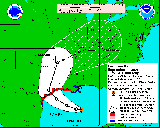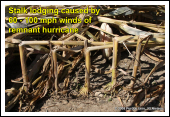Published 28 Sep 2008
URL: http://www.kingcorn.org/news/articles.08/StalkLodgingLosses-0928.html
Yield Losses and Harvesting Challenges for Severely Lodged Corn
R.L.
(Bob) Nielsen
Agronomy Dept., Purdue Univ.
West Lafayette, IN 47907-2054
Email address: rnielsen
at purdue.edu
![]() he
remnant of Hurricane Ike moved through southern Indiana
he
remnant of Hurricane Ike moved through southern Indiana  about
two weeks ago packing winds in excess of 60 mph that caused damage to corn
crops ranging from mild stalk lodging to nearly totally flat fields. Some
of the fields were already mature and not far away from harvest moisture,
while other fields were late-planted and still immature (ranging from about
early dent to half-milkline). Some of the lodging occurred primarily in areas
of fields where stalk rot development was also severe, but not in all cases.
Severe lodging also occurred in perfectly healthy, albeit very late-planted,
corn. Assessing the yield losses prior to actually harvesting damaged fields
is difficult because the losses will be a mixture of physiological (death
of immature corn), mechanical (challenges of harvesting downed corn), and
quality-related (kernel molds and premature kernel sprouting) factors.
about
two weeks ago packing winds in excess of 60 mph that caused damage to corn
crops ranging from mild stalk lodging to nearly totally flat fields. Some
of the fields were already mature and not far away from harvest moisture,
while other fields were late-planted and still immature (ranging from about
early dent to half-milkline). Some of the lodging occurred primarily in areas
of fields where stalk rot development was also severe, but not in all cases.
Severe lodging also occurred in perfectly healthy, albeit very late-planted,
corn. Assessing the yield losses prior to actually harvesting damaged fields
is difficult because the losses will be a mixture of physiological (death
of immature corn), mechanical (challenges of harvesting downed corn), and
quality-related (kernel molds and premature kernel sprouting) factors.
Click on an image to open a larger version. To close the popup window, click on the larger image.
Some of the key issues with corn that lodges severely late in the growing season are listed below. Unfortunately, the consequences of many of them are simply unavoidable. The sooner farmers can harvest these fields, the better, with the understanding that grain moisture still needs to be low enough to avoid mechanical injury by the combine (no wetter than about 25% moisture).
Physiological Yield Loss
Physiological yield loss caused by severe stalk lodging late in the growing season depends primarily on stage of kernel development (Nielsen, 2008). If the grain was already physiologically mature (i.e., kernel black layer), then technically no physiological yield loss occurs from severe stalk lodging. If the grain was not yet physiologically mature, then the magnitude of the physiological yield loss will depend on how close the grain was to maturity and whether the lodged plants die completely or hang on for some time.
It is important to remember that corn grain will always develop a kernel black layer whether healthy, stressed, or killed prematurely. If the stalks were crimped but not broken by the strong winds, the plants will die a slow death and kernel black layer will develop prematurely. If stalk-crimped plants slowly die over a 2 to 3 week period, some remobilization of stored carbohydrates from the stalks and leaves to the yet maturing grain will likely occur that will minimize potential yield losses. If stalks were literally broken by the strong winds, the plants technically die within hours and premature kernel black layer will develop even more quickly. Much less, if any, carbohydrate remobilization will occur and yield loss will be severe. Premature kernel black layer development is usually accompanied by smaller than desired kernels and resulting "rubbery" ears that can be difficult to shell without re-adjusting combine settings.
Click on an image to open a larger version. To close the popup window, click on the larger image.
We can use information documented from completely defoliated corn published by Afuakwa and Crookston (1984) as a guide for estimating yield loss due to death of stalk lodged corn. These researchers completely defoliated corn at three different kernel stages; then either harvested ears immediately (a mimic of complete plant death) or harvested ears when they had reached the kernel black layer stage (time for remobilization). Yield loss to immature corn by complete stalk breakage will likely be similar to plants that are simply harvested at immature stages (the defoliation column in Table 1). Yield loss to immature corn by crimped stalks and a slow plant death will likely be similar to plants that were completely defoliated but not harvested until kernel black layer had occurred (the maturity column in Table 1). The "late dent" stage listed in Table 1 is approximately the so-called half-milkline stage of kernel development (Nielsen, 2008).
Table 1. Estimated yield loss due to complete defoliation at different kernel
development stages and harvested at either time of defoliation or at time
of kernel maturity.

Mechanical Yield Loss
Obviously, the mechanical challenges of harvesting severely downed corn can be daunting and the risk of significant mechanical harvest loss due to severe stalk lodging can be significant. Leaving whole ears on the ground increases mechanical harvest loss much faster than the usual shelling losses of combine harvesting. Corn reels are the most common combine attachment used to facilitate picking up downed corn during harvest (Roth, 2008), but severe mechanical harvest losses can still occur if stalk breakage is severe enough. Harvesting severely lodged in only one direction may help the header pick up the downed stalks, but necessitates a lot of "deadheading" as you navigate without harvesting back to the other side of the field to harvest in the same direction again. Some growers advocate harvesting a full header width in the direction the stalks are broken, "deadheading" back, shifting over less than a header's width, harvesting another header's width in the direction of the broken stalks, then harvesting the partial header width strip back in the opposite direction and repeating the process (Hicks, 2004).
Grain Moisture & Quality Challenges
Grain moisture at harvest in fields where immature corn suffered varying degrees of stalk lodging will likely be quite variable because of the varying times of plant death and kernel maturation. Grain from plants that remained standing will mature later than that of immature stalk lodged plants that die prematurely (see above photo of ear comparison). Coupled with variable kernel maturation timing is the moisture consequence of grain on ears of lodged plants that may be lying directly on the ground or in close proximity to the soil surface and, in many instances, shaded by stalks and leaves of the lodged plants (photo below).
The prolonged contact or near contact with the moisture and higher humidity of the soil surface will delay grain drying and increase the risks of the development of fungal ear molds and premature kernel sprouting prior to harvest (photo below). Growers will be challenged to find the best compromise in grain moisture between the standing and lodged plants. The combination of variable grain moisture, possible kernel molds, and premature kernel sprouting all increase the challenges of successfully storing the grain in good condition. Grain from severely lodged fields or areas of fields may need to be segregated from that harvested from better standing fields. A number of grain storage publications are available at Purdue's Post Harvest Grain Quality & Stored Product Protection Program Web site (http://cobweb.ecn.purdue.edu/~grainlab).
Related References
Chapko, Louis. Harvesting Severely Lodged Corn. Pioneer Hi-Bred Int'l. [On-line]. Available at https://www.pioneer.com/growingpoint/agronomy/crop_insight/corn_harvest.jsp. [URL accessed 9/28/08]. (Access requires free registration to Pioneer's GrowingPoint Web site.)
Hanna, Mark. 2006. Harvested Lodged Corn. Iowa State Univ Extension. [On-line]. Available at http://www.ipm.iastate.edu/ipm/icm/2006/9-18/lodged.html. [URL accessed 9/28/08].
Heininger, R and E Dunphy. rev. 2000. Assessing and Handling Hurricane Damaged Corn. North Carolina State Univ Extension. [On-line]. Available at http://www.ces.ncsu.edu/plymouth/cropsci/docs/assess.html. [URL accessed 9/28/08].
Hicks, Dale. 2004. Harvesting Lodged Corn. Univ of Minnesota Extension. [On-line]. Available at http://www.extension.umn.edu/cropenews/2004/04MNCN24.htm. [URL accessed 9/28/08].
Lauer, Joe. 2007. Equipment for Harvesting Lodged "Down" Corn. Univ of Wisconsin Extension. [On-line]. Available at http://corn.agronomy.wisc.edu/AA/A050.htm. [URL accessed 9/28/08].
Nicolai, Dave and Dale Hicks. 2006. Corn Development and Maturity as Affected by Wind Storm Damage. Univ of Minnesota Extension. [On-line]. Available at http://www.extension.umn.edu/cropenews/2006/06MNCN53.htm. [URL accessed 9/28/08].
Nielsen, R.L. (Bob). 2008. Grain Fill Stages in Corn. Corny News Network, Purdue Univ. [On-Line]. Available at http://www.kingcorn.org/news/timeless/GrainFill.html [URL accessed 9/28/08].
Roth, Greg. 2008. Corn Harvesting Equipment for Wind Damaged Corn. Penn. St. Corn & Soybean Management. [On-line]. Available at http://cornandsoybeans.psu.edu/lodgeequipment.cfm. [URL accessed 9/28/08].
Vagts, Todd. 2003. Reducing Harvest Losses in Lodged Corn Fields. Iowa State Univ Extension. [On-line]. Available at http://www.extension.iastate.edu/nwcrops/reducing-harvest-losses.htm. [URL accessed 9/28/08].









